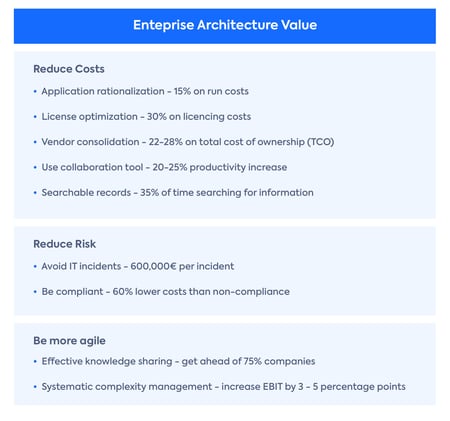Enterprise Architecture (EA) is a discipline that bridges the gap between business strategy and IT execution. When effectively implemented, EA enables digital transformation, risk mitigation, and long-term strategic planning.
However, for organizations to realize these benefits, they must go beyond theory and frameworks—they need to adopt EA as both a practice and a tool-supported function.
While EA as a discipline offers methodologies and best practices, tool adoption ensures the work is scalable, collaborative, and embedded into daily operations. Unfortunately, many EA initiatives struggle because tools are underutilized, misunderstood, or disconnected from stakeholder needs.
Whether you're a newly appointed professional in the enterprise architect role or leading a mature EA function, combining architectural thinking with tool adoption is essential to delivering impact. This page explores the core elements of EA alongside five practical strategies for driving tool adoption across the enterprise.
To ground your understanding, start by exploring the core principles of enterprise architecture, how EA creates business value, and what challenges may block progress.
📚 2025 Gartner® Magic Quadrant™ for Enterprise Architecture Tools
Enterprise architecture adoption best practices
1. Speak in clear, relevant terms
Enterprise Architecture is not widely understood across organizations—especially when it's buried in jargon. Frameworks like TOGAF or languages like ArchiMate may make sense to architects, but not to department heads, infrastructure leads, or executive stakeholders.
To increase tool adoption, adapt your message:
- For executives, highlight outcomes: cost savings, agility, and reduced risk.
- For business units, emphasize time-to-market and reduced friction in project delivery.
- For IT operations, focus on lifecycle visibility and reduced outages from outdated components.
 Quantitative estimation of EA values
Quantitative estimation of EA values
For example, instead of saying "We've aligned the metamodel to TOGAF 9.2," say "We've created a shared map of our applications, their business owners, and technical dependencies—so everyone can act faster with fewer surprises."
Also, tailor your reports. Use visual tools like heat maps and capability maps that resonate with your audience's language. Not everyone needs to know how the backend works—but everyone needs to trust what it tells them.
📚 Related: How to engage different enterprise architecture stakeholders? and How to sell EA internally?
2. Help teams solve real problems
One of the fastest ways to gain buy-in is to help other teams succeed using your EA tool. Look for high-pressure, cross-functional problems where architecture insight can help—then offer support.
Examples include:
- Helping the CIO assess which applications to invest in or divest from
- Providing M&A teams with a roadmap of the future IT landscape to uncover redundancies and synergies
- Supporting data protection officers with a filtered view of systems handling personal data
- Aiding the PMO in identifying which projects are changing which applications and how that impacts strategy

The 7 key use cases of Enterprise Architecture
You don’t need to solve every issue yourself. Instead, act as a facilitator. Run workshops, bring your EA views, and help teams reach intermediate results quickly. This builds trust and shows that EA tools enable—not delay—decision-making.
If you're looking to increase your influence within the organization, review best practices for building a reporting structure that elevates the enterprise architect’s role.
3. Maintain high-quality, accessible data
If your EA repository is outdated or unreliable, no one will use it. High-quality data is the backbone of tool adoption. That means:
- Assigning ownership for each application and IT component (business and technical)
- Establishing completion targets to avoid partial, unusable records
- Setting up automated integrations where possible to reduce manual upkeep
It’s better to have 80% of the critical portfolio covered with accurate data than a bloated model with limited usability. For example, showing your infrastructure team a lifecycle heat map they can trust is far more impactful than presenting an exhaustive but questionable application catalog.
Also, involve contributors. Give them clear incentives or responsibilities for maintaining accurate data. Architecture teams cannot do this alone.
For long-term success, ensure your data management efforts align with a comprehensive EA strategy and EA maturity levels that include process integration and stakeholder ownership.
[READ ON BELOW]




/EN-WP-EA-Tomorrow-Resource_Page_Thumbnail.png?width=260&height=171&name=EN-WP-EA-Tomorrow-Resource_Page_Thumbnail.png)
/EN-TopStakeholderQuestions-Poster_Resource_Page_Thumbnail.png?width=260&height=171&name=EN-TopStakeholderQuestions-Poster_Resource_Page_Thumbnail.png)

